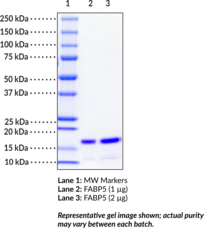Territorial Availability: Available through Bertin Technologies only in France
- Correlated keywords
- proteins lipophilic ligands uptake metabolism cellular membranes FABP-5 FABPs cytosolic fatty acids bladders carcinoma prostates atherosclerosis endocrinology
- Product Overview:
Fatty acid binding protein 5 (FABP5) is one of nine known cytosolic FABPs ranging in size from 14-15 kDa containing 127-132 amino acids.{11979} Members of this protein family exhibit high affinity for lipophilic ligands and were named according to the tissue from which they were initially isolated.{11979} FABP5 is found in skin, brain, lens, capillary epithelium, and retina. Studies suggest that FABPs are involved in the uptake and metabolism of fatty acids, in the maintenance of cellular fatty acid levels, in intracellular trafficking of these substrates, in the modulation of specific enzymes of lipid metabolic pathways, and in the modulation of cell growth and differentiation.{11977} FABP family members have highly conserved three dimensional structures and 22-73% amino acid sequence similarity. The presence of one or more disulphide bridges is a unique feature of FABP5 that may be physiologically relevant.{11977} Elevated levels of FABP5 have been observed in prostate and bladder carcinoma.{11979}
Cayman Chemical’s mission is to help make research possible by supplying scientists worldwide with the basic research tools necessary for advancing human and animal health. Our utmost commitment to healthcare researchers is to offer the highest quality products with an affordable pricing policy.
Our scientists are experts in the synthesis, purification, and characterization of biochemicals ranging from small drug-like heterocycles to complex biolipids, fatty acids, and many others. We are also highly skilled in all aspects of assay and antibody development, protein expression, crystallization, and structure determination.
Over the past thirty years, Cayman developed a deep knowledge base in lipid biochemistry, including research involving the arachidonic acid cascade, inositol phosphates, and cannabinoids. This knowledge enabled the production of reagents of exceptional quality for cancer, oxidative injury, epigenetics, neuroscience, inflammation, metabolism, and many additional lines of research.
Our organic and analytical chemists specialize in the rapid development of manufacturing processes and analytical methods to carry out clinical and commercial GMP-API production. Pre-clinical drug discovery efforts are currently underway in the areas of bone restoration and repair, muscular dystrophy, oncology, and inflammation. A separate group of Ph.D.-level scientists are dedicated to offering Hit-to-Lead Discovery and Profiling Services for epigenetic targets. Our knowledgeable chemists can be contracted to perform complete sample analysis for analytes measured by the majority of our assays. We also offer a wide range of analytical services using LC-MS/MS, HPLC, GC, and many other techniques.
Accreditations
ISO/IEC 17025:2005
ISO Guide 34:2009
Cayman is a leader in the field of emerging drugs of abuse, providing high-purity Schedule I-V Controlled Substances to federally-licensed laboratories and qualified academic research institutions for forensic analyses. We are certified by ACLASS Accreditation Services with dual accreditation to ISO/IEC 17025:2005 and ISO Guide 34:2009.





